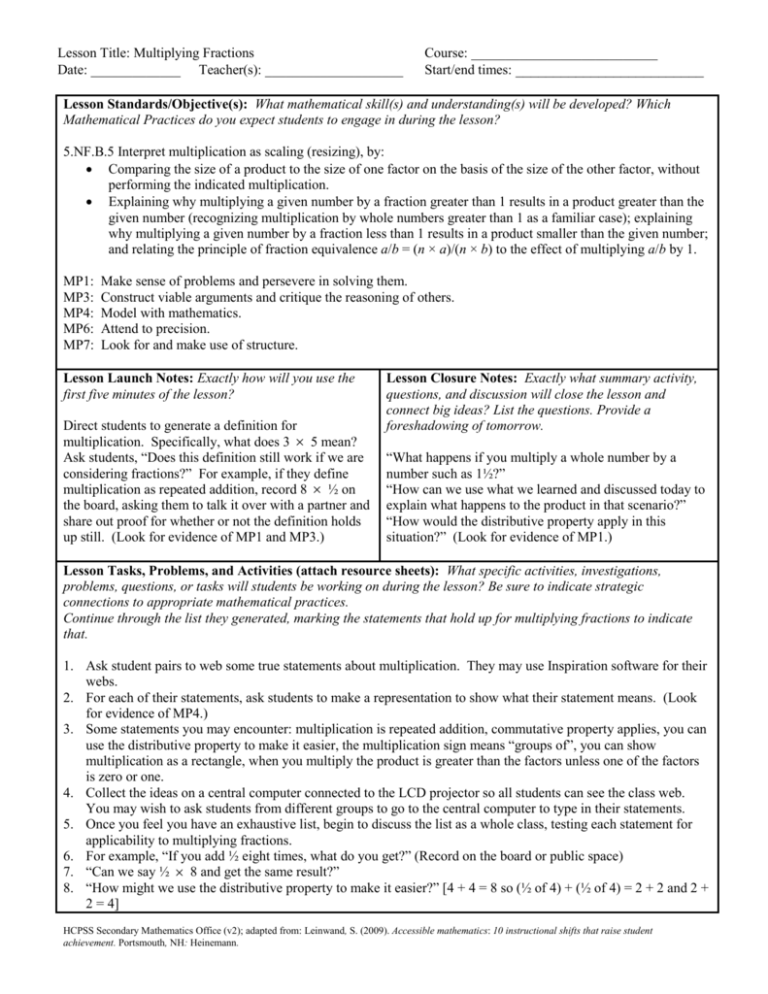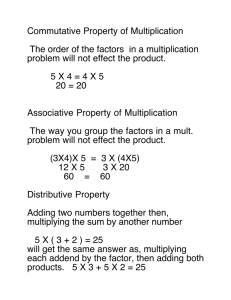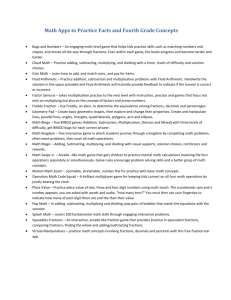5.NF.B.5 Lesson Multiplying Fractions
advertisement

Lesson Title: Multiplying Fractions Date: _____________ Teacher(s): ____________________ Course: ___________________________ Start/end times: _________________________ Lesson Standards/Objective(s): What mathematical skill(s) and understanding(s) will be developed? Which Mathematical Practices do you expect students to engage in during the lesson? 5.NF.B.5 Interpret multiplication as scaling (resizing), by: Comparing the size of a product to the size of one factor on the basis of the size of the other factor, without performing the indicated multiplication. Explaining why multiplying a given number by a fraction greater than 1 results in a product greater than the given number (recognizing multiplication by whole numbers greater than 1 as a familiar case); explaining why multiplying a given number by a fraction less than 1 results in a product smaller than the given number; and relating the principle of fraction equivalence a/b = (n × a)/(n × b) to the effect of multiplying a/b by 1. MP1: MP3: MP4: MP6: MP7: Make sense of problems and persevere in solving them. Construct viable arguments and critique the reasoning of others. Model with mathematics. Attend to precision. Look for and make use of structure. Lesson Launch Notes: Exactly how will you use the first five minutes of the lesson? Direct students to generate a definition for multiplication. Specifically, what does 3 5 mean? Ask students, “Does this definition still work if we are considering fractions?” For example, if they define multiplication as repeated addition, record 8 ½ on the board, asking them to talk it over with a partner and share out proof for whether or not the definition holds up still. (Look for evidence of MP1 and MP3.) Lesson Closure Notes: Exactly what summary activity, questions, and discussion will close the lesson and connect big ideas? List the questions. Provide a foreshadowing of tomorrow. “What happens if you multiply a whole number by a number such as 1½?” “How can we use what we learned and discussed today to explain what happens to the product in that scenario?” “How would the distributive property apply in this situation?” (Look for evidence of MP1.) Lesson Tasks, Problems, and Activities (attach resource sheets): What specific activities, investigations, problems, questions, or tasks will students be working on during the lesson? Be sure to indicate strategic connections to appropriate mathematical practices. Continue through the list they generated, marking the statements that hold up for multiplying fractions to indicate that. 1. Ask student pairs to web some true statements about multiplication. They may use Inspiration software for their webs. 2. For each of their statements, ask students to make a representation to show what their statement means. (Look for evidence of MP4.) 3. Some statements you may encounter: multiplication is repeated addition, commutative property applies, you can use the distributive property to make it easier, the multiplication sign means “groups of”, you can show multiplication as a rectangle, when you multiply the product is greater than the factors unless one of the factors is zero or one. 4. Collect the ideas on a central computer connected to the LCD projector so all students can see the class web. You may wish to ask students from different groups to go to the central computer to type in their statements. 5. Once you feel you have an exhaustive list, begin to discuss the list as a whole class, testing each statement for applicability to multiplying fractions. 6. For example, “If you add ½ eight times, what do you get?” (Record on the board or public space) 7. “Can we say ½ 8 and get the same result?” 8. “How might we use the distributive property to make it easier?” [4 + 4 = 8 so (½ of 4) + (½ of 4) = 2 + 2 and 2 + 2 = 4] HCPSS Secondary Mathematics Office (v2); adapted from: Leinwand, S. (2009). Accessible mathematics: 10 instructional shifts that raise student achievement. Portsmouth, NH: Heinemann. Lesson Title: Multiplying Fractions Course: ___________________________ Date: _____________ Teacher(s): ____________________ Start/end times: _________________________ 9. “If the multiplication sign means “groups of,” can we say eight times one-half is eight groups of one-half?” Discuss student responses. (Look for evidence of MP7.) 10. Questions to pose to students: “How can we show 8 ½ as a rectangle?” “How might drawing 8 1 as a rectangle help us?” “Would it also work for multiplying a fraction by a fraction?” “How might that look?” Consider using fraction bars or fraction snap cubes at this point with students. (Look for evidence of MP4.) 11. Say to the students: “Think about this statement: when you multiply, the product is greater than the factors unless one of the factors is zero or one. Does this hold up? Why or why not?” Pose the following question for pairs of students to solve using pictures, words, and numbers: Julian planted 8 rows of vegetables in his garden. Of the rows he planted, 4/5 were beans. How many rows of beans did Julian plant? (6 2/5 rows) 12. Circulate through the class to ask students about their strategies and form a plan for building the whole group discussion. For example, you may wish to consider prioritizing responses for the discussion from most simplistic to most complex. (Look for evidence of MP1 and MP6.) 13. Bring the class together to discuss their solutions, asking students to explain their strategies and their representations. (Look for evidence of MP3 and MP4.) 14. Help students understand what the whole is at each stage. For example, some approaches may consider all eight rows first as the whole. Then they may consider 5 rows as a whole, marking off 4 out of the 5 rows as beans. Next they may consider the remaining 3 rows individually, breaking them into five equal parts and marking 4 out of 5 of the sections as beans. When they put the sections together, they will have 6 and 2/5 rows. 15. Ask others to share different solutions and discuss, comparing and contrasting the different solutions. (Look for evidence of MP3.) Evidence of Success: What exactly do I expect students to be able to do by the end of the lesson, and how will I measure student success? That is, deliberate consideration of what performances will convince you (and any outside observer) that your students have developed a deepened and conceptual understanding. By the end of the lesson, students should be able to articulate and represent multiplication of fractions as connected to repeated addition of fractions. Their drawings should clearly depict that relationship and be complete with labels and equations. Notes and Nuances: Vocabulary, connections, anticipated misconceptions (and how they will be addressed), etc. Vocabulary: numerator, denominator, fraction, repeated addition, multiplication, factor, product Connections: repeated addition, sets of, in part-whole fractions the whole is divided into equal parts Help students connect 3 x 5 (or 3 groups of 5) to 8 x 4/5 (or 8 groups of 4/5) Misconceptions: Look for students who struggle when the whole changes in the problem. They will need additional work with part and whole tasks. Resources: What materials or resources are essential for students to successfully complete the lesson tasks or activities? Homework: Exactly what follow-up homework tasks, problems, and/or exercises will be assigned upon the completion of the lesson? Computers (1 per pair) with Inspiration software (optional) Fraction Bars or Fraction Snap Cubes (for demonstrating repeated addition of fractions) Grid paper (for drawings) See Student Resource Sheet “Draw and Multiply” Lesson Reflections: How do you know that you were effective? What questions, connected to the lesson standards/objectives and evidence of success, will you use to reflect on the effectiveness of this lesson? HCPSS Secondary Mathematics Office (v2); adapted from: Leinwand, S. (2009). Accessible mathematics: 10 instructional shifts that raise student achievement. Portsmouth, NH: Heinemann. Lesson Title: Multiplying Fractions Course: ___________________________ Date: _____________ Teacher(s): ____________________ Start/end times: _________________________ How do the student representations show the situation in the task? Are students correctly using the meaning of the numerator and denominator? Howard County Public Schools Office of Secondary Mathematics Curricular Projects has licensed this product under a Creative Commons Attribution-NonCommercial-NoDerivs 3.0 Unported License. HCPSS Secondary Mathematics Office (v2); adapted from: Leinwand, S. (2009). Accessible mathematics: 10 instructional shifts that raise student achievement. Portsmouth, NH: Heinemann.







